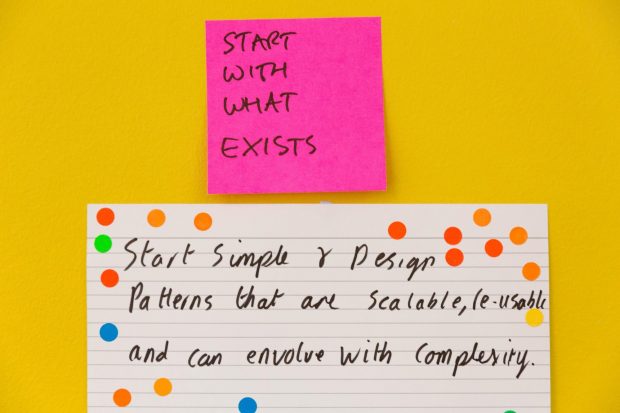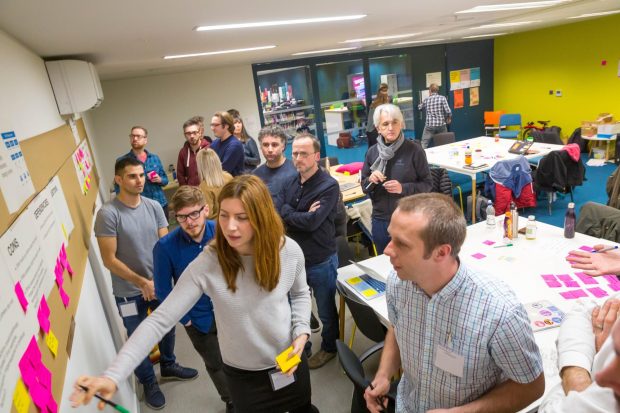
We introduced the GOV.UK Design System with a clear goal in mind. To reduce duplication of effort and inconsistency by providing one place for teams to find the things they need to design government services.
It’s been 6 months since the GOV.UK Design System went in to public beta, and uptake in departments has been widespread and encouraging.
But we know that some departments still use their own design resources alongside the Design System, and we wanted to know more about why this was.
Holding a government design resources discovery
In November 2018 we ran a discovery to learn more about why departments use their own design resources, and some of the barriers to using the GOV.UK Design System.
We looked into design systems across government once before, but this was before the launch of the GOV.UK Design System, so we decided to revisit this in today’s context.
In the discovery we found 57 departmental design resources of various kinds, including:
- design systems
- pattern and component libraries
- design handbooks and manuals
- prototyping tools like the GOV.UK Prototype Kit
We interviewed people working on these kinds of resources across 7 departments, focusing on one question: How should the GOV.UK Design System interact with other design resources in government to provide the best user experience?
Why departments create their own design systems
We learned that departments create their own design systems to:
- establish consistency within their department
- provide things that are not in the GOV.UK Design System, such as headers, footers and typographic styles for internal services
- publish things quickly without having to go through the GOV.UK Design System’s contribution process
- provide code that’s compatible with their technologies
- tailor components and patterns to their users
Cross-government design systems workshop
We ran a workshop on 6 December 2018 to further explore our findings with the creators and maintainers of department design systems.
In total, 35 representatives from Her Majesty’s Revenue and Customs, Home Office, Ministry of Justice, Her Majesty’s Court and Tribunals Service, Department for Work Pensions, Driver and Vehicle Standards Agency and Her Majesty’s Land Registry joined.
Departments shared examples of their work and then broke into groups to:
- agree principles for creating and contributing to government components and patterns
- discuss common challenges
- compare 3 models for organising government design systems
Principles for developing government components and patterns
We know that many users need to use both the GOV.UK Design System and department-specific components and patterns.
By establishing some ground rules to follow when creating these resources, we hope to provide a better experience for those users.
We ran an activity to create some principles. Participants drafted principles in groups of 4, then shared their ideas back to the whole group, before everyone voted on a top 3.
The resulting principles were:
- Start with what exists
- Contribute back and help others
- Prioritise openness and honesty

We’ve published the principles in full in the GOV.UK Design System to show that we’re committed to following them as a community going forward.
Discussing the common challenges of design systems
Following this session, we broke into groups to discuss 6 common challenges that emerged from our discovery research. We talked about how we might work together to:
- collaborate better across government
- make components usable with different technologies
- use design systems to promote a shared way of working
- support people working on caseworking systems
- strike the balance between promoting reusable resources and iteration
- ensure that the design system meets the needs of all its users
We’ve reviewed the suggestions and used them to help build the Design System team’s roadmap for the next year.
Comparing models for organising government design systems
In the final activity, we explored the pros and cons of 3 different models for organising government design systems. These were:
- A single, centralised design system that everybody uses – there is one version of each component and pattern and no departmental variants.
- A single, federated design system that everybody uses and contributes to – this model could contain departmental variants.
- A central design system that everyone can contribute to as well as department design systems – department versions could be copies of the GOV.UK Design System with their own things added, or only contain things not in the GOV.UK Design System.

We agreed that we’re currently closest to the third model, but most participants wanted to move towards a more centralised model in which:
- users can find what they need in one place
- everyone can contribute, and the process for doing so is clear and transparent
- departments can publish what they need, when they need it
- it’s clear which things teams will be assessed against
To achieve this, in the next year we’re going to focus on:
- publishing things from department design systems in GOV.UK Design System
- making the contribution and assurance process easier and more efficient
- making it easier for departments to develop and share their own components
What now?
We’ve already published the principles for creating and contributing to government components and patterns and built some of the key actions from the workshop into our roadmap.
Over the coming year, we want to keep talking to people who are creating, maintaining and using design systems in government.
If that’s you, and you’d like to talk to us, you can:
- join the #govuk-design-system Slack channel
- come along to our weekly design systems catch up every Friday at 2pm on Google Hangouts – email govuk-design-system-support@digital.cabinet-office.gov.uk and we’ll add you to the invitation.
